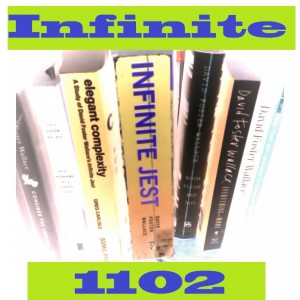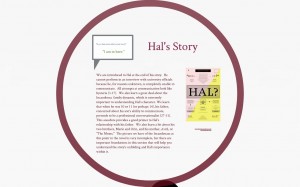 1079 pages. 388 footnotes. 2 lbs 10 oz (and that’s the paperback). David Foster Wallace’s Infinite Jest is nothing if not formidable. It languishes on many a “to-read” shelf alongside Joyce’s Ulysses and Pynchon’s Gravity’s Rainbow. Despite its intimidation factor, Infinite Jest can be a pretty accessible read, and it is absolutely a rewarding one. Infinite Jest deftly critiques politics, entertainment, cavalier abuse of the environment, and the advertising industry; hauntingly captures the nature (and process) of depression and addiction; carefully thinks through heady philosophical, theoretical, and at times mathematical logics (and illogics); confidently responds to Shakespeare’s Hamlet; digs deeply into social fabrics and family dynamics; and perhaps most important, asks of its reader to question why we are so vulnerable to addictions, to endless entertainment. And it does all of this in a near distant future (with respect to its publication date; it is actually at this point set approximately two years ago).
1079 pages. 388 footnotes. 2 lbs 10 oz (and that’s the paperback). David Foster Wallace’s Infinite Jest is nothing if not formidable. It languishes on many a “to-read” shelf alongside Joyce’s Ulysses and Pynchon’s Gravity’s Rainbow. Despite its intimidation factor, Infinite Jest can be a pretty accessible read, and it is absolutely a rewarding one. Infinite Jest deftly critiques politics, entertainment, cavalier abuse of the environment, and the advertising industry; hauntingly captures the nature (and process) of depression and addiction; carefully thinks through heady philosophical, theoretical, and at times mathematical logics (and illogics); confidently responds to Shakespeare’s Hamlet; digs deeply into social fabrics and family dynamics; and perhaps most important, asks of its reader to question why we are so vulnerable to addictions, to endless entertainment. And it does all of this in a near distant future (with respect to its publication date; it is actually at this point set approximately two years ago).
Infinite Jest might not seem at first pass like a top choice to teach in English 1102, but actually, it’s the perfect 1102 text. Infinite Jest is such a long and complex novel that one needs multiple reading/interpreting/writing strategies in order to stay oriented to the storyworld. In this class, I’m cultivating two very different (and yet profoundly related) strategies—one that focuses on the global aspects of the book, a strategy that maps the storyworld, and one that focuses on digging deeply into a particular aspect of the text (and indeed, the paratext, as much of this exploration must occur through footnotes). We might think of this two-fold strategy as the extreme nodes of a zooming function. The student must learn to metaphorically zoom in and out in order to engage this text.
This strategy of zooming lends itself well to creating multimodal responses to this text. First, because of the expansive complexity of the storyworld, students need to be equipped with mapping strategies— maps of space, time, characters, and plot threads. This map-making, categorizing, and organizing of the elements of the novel, including keeping track of the diegesis itself, demands of the student a widened view. Taking a step back to look at the text as globally as possible when reading it for the first time (this task being greatly aided by a T-Square repository of links to multimodal texts already extant that respond to Infinite Jest and can serve as both guideposts and models), the students are able to begin to understand the storyworld by way of using WOVEN to engage in summary, analysis, synthesis, and critical reflection.
One assignment in particular serves to create a sense of that global view while simultaneously keeping in mind that zooming in to a particular aspect is also an important part of understanding this text. In this assignment, the students must each create (individually) a Prezi for one day’s reading of Infinite Jest. This Prezi performs two functions and fulfills two purposes. First, the student must present it in 7-9 minutes at the beginning of the class, using it as a way to facilitate discussion. Second, the student must upload the link to T-square. By the end of the semester, we will have a visual representation of each section of the book. This repository serves as a sort of collection of maps, each individually created and yet, in the end, part of a collaboratively written whole. Additionally, each Prezi must develop at least one aspect of that day’s reading that the student wants to highlight, so while this assignment largely fosters the widened view, it also keeps the students mindful of the tight focus view.
The zoomed-in view asks the student to delve deeply into something specific in the text. This tight focus view manifests in a myriad of ways, including crafting promotional material for what might be considered “paratext.” Footnotes comprise 96 of Infinite Jest’s 1079 pages. Some of these notes are crucial exposition, some are seemingly tangential information, and some are fictional entries about fictional drugs. In other words, Wallace is playing with the way we think about footnotes. We cannot treat these notes as extra-textual, and yet only some are crucial to the story. We must engage in active and deep reading in order to access the storyworld Wallace envisions.
In note 24, which spans pages 985-993, the narrator provides James Incandenza’s entire filmography, information that is important to a deep understanding of the character and of the film cartridge that lies at the center (if such can be found here) of the story. In a series of assignments, students are asked to imagine themselves as directors or writers of one of the films listed in note 24 (they are doing this in groups of 5, so they can think about this in terms of a production team if they so desire) and develop promotional materials for that film. First, they must produce a movie poster and be prepared to talk about their film from within a directorial persona at an Exhibition in February (stay tuned for invitations). Much later in the semester, their group must create a 90-120 second movie trailer and write a hypothetical critic’s review of the film. Requiring the students to dig into this seemingly “extra stuff” encourages their critical thinking function and their ability to read texts transformatively. Students navigate various diegetic levels, revising and expanding upon them by engaging new modes to render the material and deepen the interpretive experience.
Thinking through the class as an exercise in manipulating the zoom function allows for both a broader and deeper understanding of the text as well as for multimodal assignments that engage those perspectives in novel and helpful ways. In the next installment, I will detail the Exhibition in February and extend formal invitations. For now, I leave you with the first three Prezis of the class, all of which I created (with no student participation) in order to show the various ways students might approach this assignment.


Awesome! That sort of running Prezi assignment throughout the class not only lends itself to this particular text, but also casts a multimodal/presentational lens on the semester as a whole. I’ll be curious to see the students’ overviews after they have finished the book.
Pingback: Untouchable E-Books: Mulk Raj Anand, Modernism, and Technolog - TECHStyle
Pingback: Postcolonial Digital Humanities | Untouchable E-Books: Mulk Raj Anand, Modernism, and Technology
Pingback: Expect to Be Disappointed? Moby-Dick and ENGL1102 (Part I) - TECHStyle